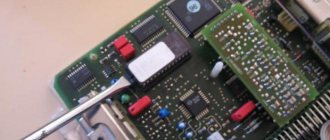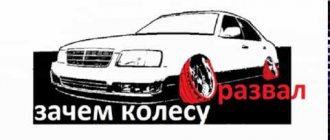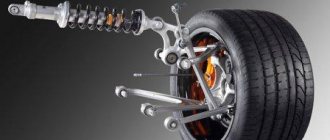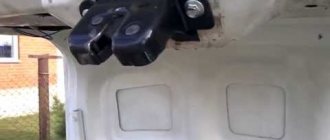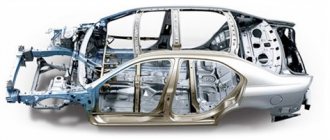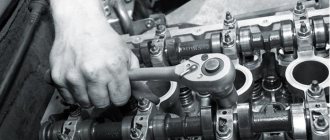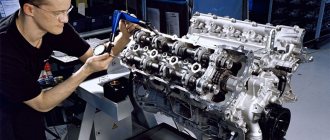Electronic engine control unit (ECU, controller) — the brain center of the car. It receives signals from all systems, coordinates and monitors faults.
Some ECU functions:
- controls fuel injection;
- adjusts the throttle position;
- controls ignition;
- analyzes the composition of exhaust gases;
- controls valve timing;
- identifies malfunctions and informs the driver about them.
What is engine ECU firmware?
Engine ECU programming is initially done by the manufacturer. However, the stock firmware is not adapted to specific climatic conditions and driving style. Moreover, on modern cars power is limited by software due to environmental requirements. ECU firmware is a change in parameters in the factory program, which allows you to bypass restrictions.
An analogue of firmware for an electronic control unit is installing an operating system on a computer or smartphone. With the same hardware, the results are different.
Firmware advantages:
- Power and torque will increase;
- Acceleration will become faster;
- If desired, the catalyst or particulate filter is switched off;
- Improves performance when the air conditioner is on;
- The gas pedal responds faster;
- Turbo lag disappears (engines with a turbine).
Disadvantages of the firmware:
- You need to refuel at proven gas stations;
- The load on the environment increases when switching to E2.
We learn how to flash the ECU ourselves using the example of a VAZ 2115I
14.03.2012
| Go to section: Equipment for ECU flashing Key and chip programmers All equipment selected by car brands and models |
Well, my dream has come true - to change my “Masquerade” to something newer and more modern. The choice fell on the VAZ 2115I 1.5L 8V - enough money for the 2006 model year. Includes HBO, music, trip computer, not very good alarm system, 14mm wheels, arch protection, sump protection and worn covers. A list of priority work was quickly determined - a repair kit for the gas reducer and the whole range of work to put the gas equipment in order are needed. When running on gasoline, the car began to stall when the revs dropped (I’m not even talking about running on gas). The synchronizer for 2nd gear was worn out, an urgent oil and antifreeze change was required, the radiator dripped from below and a crack in the expansion tank was discovered. Thus began the study of the equipment of this car. But the Russian car enthusiast will not be scared by the VAZ after such models as “Zaporozhets” and “Moskvich”!
A year of operation has passed and the list above has been supplemented by replacing the starter, purchasing a new mass air flow sensor, idle air regulator, installing a new alarm system with feedback, and replacing a pair of fog lights broken by stones. But no matter how hard you try, bugs still remain on the products of our automotive industry. You could think about another car, but it’s a pity for the labor and money invested. True, replacement of parts was carried out only after repeated attempts to repair the next unit independently. I managed to do something, and if I have the opportunity, I will try to write articles on the following topics: repair and adjustment of the LPG gearbox, repair of the starter, installation of an alarm system.
Now I’ll focus on reflashing the ECU in order to teach the VAZ to drive. To begin with, I affirm that it is possible and even necessary to sew our domestic product. Moreover, a car that has not been serviced since birth, and I think there are 50 percent of these from the entire fleet of injection VAZs. Flashing is very easy and simple - click a couple of icons on the computer, click a couple of toggle switches and it’s as if rocket fuel was poured into your car! But understanding how all this is done, combining different information into one whole is not given to everyone and is much more difficult. Here is my respect for real masters! Alas, you most likely will not find ready-made information laid out on shelves anywhere. On the Internet you can piece this together by reading and re-reading numerous forums. It took me about six months before the first re-flashing with 2-3 “approaches to the projectile”. During this time, I mastered the firmware of other electronic devices, such as satellite receivers, setting up their work on the globe, setting up satellite Internet, operating motor suspensions and setting up the entire satellite system to the final result.
Don’t think that writing this lengthy article was motivated by a desire to write, everything is much simpler: it’s just that during the first attempt to read the firmware from the ECU, I immediately failed - the car stopped starting! Having lost some of her nerves (it was almost at night, and in the morning she had to go to work), fortunately we managed to partially revive her - we managed to fill in the stock gasoline firmware (the gas part is still silent). Faced with such a problem, I want to do something to help those interested in this issue and so that no one steps on the same rake as me.
Before you start working on your own, you must:
- • prepare theoretically; • prepare equipment (make or purchase a K-line adapter, a tested computer and everything else that is needed to • replace the software; • find and download the necessary software for your computer; • find firmware for the ECU.
I don’t pretend to be the ultimate truth, so I ask you not to criticize too much for the style and possible inaccuracies, but:
1. Usually there is a need for firmware to fix obvious bugs in the factory software, add car dynamics, or a desire to save fuel. This is also necessary when using liquefied gas as a fuel along with gasoline. Another thing is to simply study better the structure and operation of the engine control system.
2. It is better to carry out preparation gradually. Don't try to cover everything at once. It is important to understand the principles of working with electrical and electronics, and to have good computer skills in terms of installing programs and drivers. For the rest, the Google search engine will help, you just need to formulate your queries more specifically. For example: Esud VAZ; controller connection diagram; instructions for ECU firmware; K-Line adapter diagram; firmware; chip tuning of vases, etc. It is necessary to determine the types of ECUs and their markings, which engine needs which firmware and their designations. Deal with the immobilizer issue. When you realize that you have understood everything and decided that you have become a great specialist, do not hesitate and go to the service technician and try to discuss the virtual topic of replacing the firmware of your car and disabling (deactivating) the immo. I don’t recommend “torturing” a mechanic for a long time because you will take up the person’s time and most likely you will quickly have new questions, the answers to which are better to find on your own or ask for help on auto forums.
3. If your hands grow from the right place, then the adapter is not very difficult to assemble. The simplest one for a hardware COM port based on MAX232 and K1533LN1 and KT3102 can be found on the website Chip-tuner.ru. It will cost about a hundred even if you buy the entire package at a radio market. For starters, he'll go. True, there is a trap here - not all system systems have a standard COM port, and even those that have it may not work. I have exactly the same motherboard - the COM port works, programs like POBEDIT (for satellite OPENs) work, but flashing programs do not work. The shamanism with drivers and settings in the BIOS did not lead to anything. Installing new operating systems is the same without changes. Everything worked on someone else's computer. For such a case, an old data cable from a cell phone based on a PL 2303 microcircuit and + one ms L9637D can help. The scheme works 100% (tested on January 7.2), you just need to add one line in the driver registry with parameters for non-standard ECU speeds. You will get a USB-K-Line adapter. If you add 2 more transistors and a couple of parts, you can also get an L-line. In order not to go to the market for one ms, I sacrificed the polite interior lighting and removed 9637 from the APS-4 immobilizer.
As a connector I used 2 blocks from a computer IDE cable without modifications. The cable was cut into 2 pieces of 10-15 cm each. On January 7.2 they fit well under the top and bottom of the ECU socket (empty 2 pins of the pads remain at the top or bottom of the block legs), just when reconnecting, do not confuse their location, otherwise you will burn the block. I also used 3 microtoggle switches - common +12V, ignition “+” and switching to programming mode “+”. Before any operation, I turn off the 2nd and 3rd toggle switches, and turn them on in the order of 3 then 2. Sometimes I have to remove the general “+” for a short time to receive communication. Power can be taken from the car, when working on a table “-” from an adapter with a current of about 500 mA.
4. To flash the firmware, you need the following programs: combiloder 2.18 and chiploader 1.6 (1.96 is more expanded in blocks). The first program is included in the Stp321-full kit (the loader is free and will start working when the adapter is connected). But sometimes he falls out of work or cannot complete the pouring process. The second one works without problems. The first one is needed mainly to remove protection from the firmware you find and to install the same protection when uploading software to the ECU. It is not possible to read protected software from the controller - it is erased. Therefore, I advise you to prepare and have at least several (taken from different places) factory firmware. After installation, the Stp321-full catalog contains a set of standard and tuning firmware, which may be suitable. You also need programs such as chipexploer 1.6 and Page 4.10 (with a tail). These programs will allow you to view the found firmware, edit, compare them with each other and assemble dual pr-ki. On 2-core computers (and with the hyper-trading function), the tail falls off on Page. Somewhere I came across information about a patch for this problem, on single nuclear ones everything is fine. Be sure to carefully study the help for these programs and work with the firmware in them in order to understand the features and capabilities of the programs. This way you will most likely weed out broken and questionable firmware. 2 more programs - Enigma for decoding software from the CTP standard and ICD for checking the adapter. It is better to take this entire set from the deposit (there are rarely non-working ones there). You will also get links to other resources when reading the forums. I recommend saving to your computer all useful pages, diagrams, photographs and documents found while surfing the Internet. It will come in handy more than once.
If, after reading the article up to this point, you still have the desire to learn and move on (reflash your car), I will be very glad and wish you all success. Proceed with what you have planned, but keep in mind that all responsibility continues to fall on you. If you are not sure or are afraid, contact the specialists.
While I was writing the opus, I found gas software, put together a dual petrol “+” gas system, filled it up and drove off. Made I203EL36/RB40, I203Ez36/RB40. Even with this software I felt a difference from my native EL35. I left any questions and ambiguities that arose until they were clarified.
← Diagnostics and repair of electrical systems of Mercedes and BMW of the 90s Frequent, typical faults of Peugeot →
Equipment selection:
What is corrected in the ECU firmware
Depending on the purposes of chip tuning, up to 1300 calibrations are made when programming the engine ECU. Most often the changes concern:
- fuel supply, enrichment thresholds, fuel supply restrictions during acceleration;
- boost pressure on turbocharged engines in economy and power modes;
- hardware configuration bytes and error mask;
- torque, fuel supply and boost limits;
- operating algorithm of the mode manager;
- TP shutdown speed limits and V max.
Preparing for chip tuning
Before you start an “electronic upgrade” of your car, you should perform several important operations, which are the key to ensuring that the tuning will only be beneficial and will not cause any harm to the car, namely:
- check the condition of all, and especially heavily loaded components and assemblies. After all, the main goal of reconfiguring the ECU is to increase power and torque, as a result of which heavily worn parts can become damaged and even fail;
- clarify whether reprogramming is possible in your case. The fact is that not all programs allow you to establish such “feedback” and make changes, which means that trying to change them is useless;
- find out the value of the inherent potential. Thus, when programming the ECU at the factory, manufacturers in the vast majority of cases leave a “reserve” of power, as a result of which the engine does not operate at full strength and has hidden capabilities, which reprogramming is intended to extract. In the same case, if the engine is already working at its maximum from the factory, no amount of chip tuning will help.
ECU VAZ 2114
In addition to the points listed above, you should also take into account the fact that before starting the upgrade, it is highly advisable to replace all filters in the car (and especially the air filter). After all, only performing programming on a completely “updated” machine will give the maximum result.
It is also worth remembering that after chip tuning the car will need higher octane fuel. So, if before the upgrade the engine was running on 92, then after it is completed you will need 95.
How to install the firmware
- Chip tuning begins with engine diagnostics. There is a rule: you cannot sew a faulty car.
- The original ECU firmware or identifiers are read. It is modernized or a ready-made optimized version is selected.
- Next, the firmware is written. Some units are flashed without removal and disassembly using an adapter via the OBDII diagnostic connector. Others have ECUs that are removed for reprogramming. In this case, there are options with or without disassembly and soldering.
- The ECU is installed in place. The owner makes a test drive.
DIY instructions for flashing engine control module firmware
If you decide to reflash the module yourself, then in order to do everything correctly yourself, you need not only to select the necessary programmer and software, but also to know the pinout of the connectors. Below we suggest that you familiarize yourself with information regarding the choice of software (video published by the VideoMix channel).
Equipment
First of all, you need to choose an editor. The editor is a specialized program, the main purpose of which is to make adjustments to the settings of the control module. Nowadays, you can buy an editor for changing ECU files in any specialized store. We recommend choosing editors from well-known manufacturers, so you will be sure that you are working with high-quality software.
Let's look at the most popular versions of adjustment equipment:
- Delphi MT60. This software is considered the most universal option, since it can be used to work with most modern devices, in particular Mikas. Finding a Delphi MT60 today is not a problem.
- Galletto 1260 - this programmer is considered one of the easiest to use. In practice, this equipment can only work with Bosch EDS16 and EDS15, Siemens, Delco, ME units of all versions. The device can easily reflash control units in both diesel and gasoline vehicles; the OBD-II interface is used for flashing. The kit includes an adapter plug from OBD to VAG 2×2. When using this device, the manufacturer recommends that you separately save a backup copy of the main firmware files of the unit. During the process, be sure to turn off additional devices and devices and make sure that the radiator fan is turned off. In case of problems with the vehicle's on-board network, reprogramming is not recommended.
- Openbox is an equally popular option that has become widespread among our compatriots. This editor can also work with many models of control modules, including VAZ January (almost all versions), Bosch, and Mixa. In fact, Openbox works well with other models of on-board computers. If used correctly, you can improve the basic performance parameters and characteristics of the car, as well as enhance protection against theft. If you use this utility, then for its proper operation you will need a special module; it will be connected via a cable to the ECU.
- MPPS. This editor can be used in almost all European, American and Asian cars. The device allows you to read and write information to the controller’s memory via the OBD-II output via a direct connection. One of the main characteristics of the device is the high speed of firmware, as well as a multilingual interface, including Russian.
- ChipExplorer is also a universal and easy-to-use program that is suitable for working with almost any control modules.
Photo gallery “ECU programmers”
Nuances that are important to know
So how to flash the control unit and what nuances should be taken into account when performing this task? The programming procedure is carried out by connecting the computer to the control unit through a programmer and making adjustments to its parameters. Here, a lot depends on the specific control unit, software, and programmer.
When purchasing a device, we recommend that you carefully check the package contents of the device, which should include:
- a utility with which the adjustment will be made;
- the cable itself with the adapter;
- A USB key made in the form of a regular memory card (video published by the romanem0 channel).
If you do not have a key, you will not be able to use the software. Most programmers sold today have a license, which can be 12 or 18 months, it all depends on the manufacturer. If you have never encountered the need to flash a control unit before, then it is better to entrust this procedure to specialists. Otherwise, there is a possibility of making mistakes.
Why you don’t need to reflash the ECU yourself
To flash the engine ECU, the chip tuner must have knowledge, qualifications and experience. Special equipment and fresh firmware from trusted calibrators are required.
Most car owners try to do it themselves in order to spend less. But even with the equipment, the savings are minimal. If you do not plan to professionally engage in chip tuning, it is better to trust a professional. He will conduct diagnostics, select the latest firmware version and install it with a guarantee.
What is needed for electronic tuning
The main “tools and devices” that will be needed when performing firmware for the VAZ 2114 8 valves are:
- Programmer.
- Disk with the required firmware version.
- PC or laptop.
ChipTuningPRO at work
If there are no problems with the last two points, then the programmer will need to be purchased. This can be done either in a car store (if not in stock, then order it) or via the Internet. It is worth considering that this device is far from cheap, and buying it for a single use is not at all profitable.
The best option would be to purchase it together with other car enthusiasts or contact a specialized workshop, where all reprogramming can be performed by professionals.
Disadvantages of ECU flashing
As mentioned above, an electronic upgrade of the control unit has not only a large number of advantages, but also certain disadvantages that should be kept in mind.
These may include:
- increased load on the engine and adjacent units;
- increased fuel consumption;
- increased toxicity of exhausts;
- rapid wear of parts;
- refueling a car with more expensive fuel.
True, it should immediately be noted that most of these shortcomings (for example, excessive fuel consumption) can only appear as a result of independent and, at the same time, not very successful tuning. When performing flashing at a car service center, technicians will be able to set the operating parameters of the engine to the maximum so that they do not “overlap” each other and do not interfere with themselves.
Achieving similar results at home and in the absence of the necessary skills is extremely difficult. As a result, the by-products will be increased toxicity and waste.
Speaking of the latter, it should still be noted that when the engine power is set to maximum, the consumption will increase in any case. The only thing that can be different is the number by which it changes. If, on the contrary, you want to reduce fuel costs, then when carrying out chip tuning, you should focus on this. True, the power characteristics of the engine, on the contrary, may decrease.
